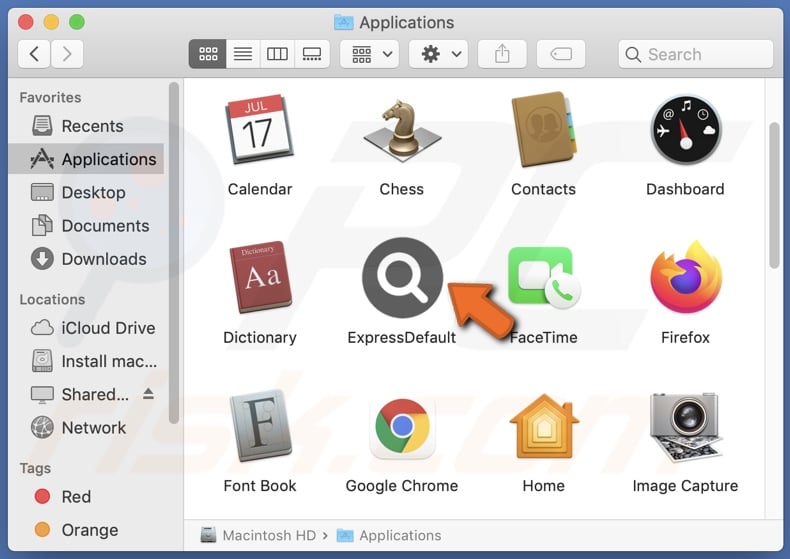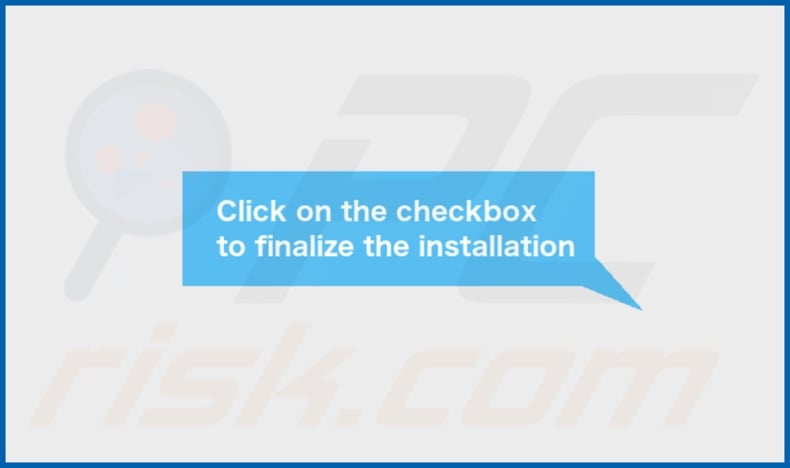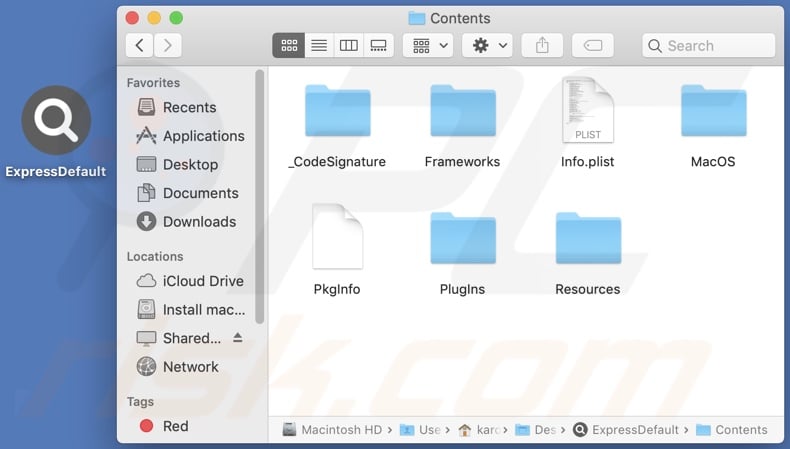How to remove ExpressDefault adware and the ads it displays
Mac VirusAlso Known As: Ads by ExpressDefault
Get free scan and check if your device is infected.
Remove it nowTo use full-featured product, you have to purchase a license for Combo Cleaner. Seven days free trial available. Combo Cleaner is owned and operated by RCS LT, the parent company of PCRisk.com.
What is ExpressDefault?
After downloading and launching ExpressDefault's sample, our researchers found it to be an adware-type app. In other words, it runs intrusive advertisement campaigns (displays various ads).
We also determined that ExpressDefault belongs to the AdLoad malware family. Furthermore, it may exhibit browser hijacker behavior (as is common for AdLoad applications), although it did not - when we analyzed it.

ExpressDefault adware overview
ExpressDefault is capable of displaying pop-ups, banners, coupons, and other intrusive adverts on visited websites and other interfaces. Adware-delivered ads can be misleading, deceptive, and even hazardous. They promote sale-oriented, rogue, untrustworthy, scam, and malicious sites. Some intrusive ads can be triggered (by being clicked) to download/install software without user consent.
During analysis, we found that ExpressDefault worked as described above. However, it is noteworthy that adware-type apps may require specific conditions (e.g., system specifications, geolocation, websites being accessed, etc.) to display advertisements. Even if ExpressDefault does not run intrusive ad campaigns on your system, we strongly recommend removing it.
Based on extensive experience with AdLoad adware, our researchers believe that ExpressDefault may operate as a browser hijacker and/or collect user data. Gathering information (e.g., browsing activity, personally identifiable details, financial data, etc.) is typical for adware.
The developers of adware monetize sensitive data by selling it. Hence, apps like ExpressDefault may cause severe privacy issues, financial losses, and even identity theft.
| Name | Ads by ExpressDefault |
| Threat Type | Adware, Mac malware, Mac virus |
| Additional Information | This application belongs to Adload malware family. |
| Symptoms | Your Mac becomes slower than normal, you see unwanted pop-up ads, you are redirected to dubious websites. |
| Distribution methods | Deceptive pop-up ads, free software installers (bundling), fake Flash Player installers, torrent file downloads. |
| Damage | Internet browser tracking (potential privacy issues), display of unwanted ads, redirects to dubious websites, loss of private information. |
| Malware Removal (Windows) |
To eliminate possible malware infections, scan your computer with legitimate antivirus software. Our security researchers recommend using Combo Cleaner. Download Combo CleanerTo use full-featured product, you have to purchase a license for Combo Cleaner. 7 days free trial available. Combo Cleaner is owned and operated by RCS LT, the parent company of PCRisk.com. |
Adware examples
We have analyzed many products within the adware classification; DigitalProgram, KeyWright, and GlobalProcesser - are just a couple of examples. This software usually looks genuine and offers "handy" features, which are rarely operational. Therefore, we strongly advise researching applications before download/installation and/or purchase.
How did ExpressDefault install on my computer?
We discovered ExpressDefault when it was installed on our test system alongside fake Adobe Flash updates, which were promoted through a "cracking" website we researched.
Dubious download channels, e.g., unofficial and freeware sites, Peer-to-Peer sharing networks, etc. - are commonly used by cyber criminals to spread harmful content. Software "bundling" (packing regular programs with undesirable additions) is a widespread technique as well, but it is not limited to fraudulent updates.
Adware can also be pushed through spam browser notifications and intrusive ads. Furthermore, the latter can stealthily download/install software - upon being clicked. Some apps of this kind have "official" promotional webpages as well.
How to avoid installation of adware?
Practicing computer safety is key to avoiding adware and other malicious software installation. Hence, our researchers recommend using only official and verified download sources. When downloading/installing, it is important to read terms, study possible options, use the "Custom/Advanced" settings, and opt-out of all supplements.
Untrustworthy content is heavily promoted on the Web; therefore, we also advise exercising caution when browsing. Intrusive advertisements/ browser notifications appear legitimate; however, they redirect to questionable sites (e.g., gambling, pornography, adult-dating, etc.).
It is crucial to check a device and remove all suspicious applications and browser extensions/plug-ins - should you experience ads and/or redirects of this kind. If your computer is already infected with ExpressDefault, we recommend running a scan with Combo Cleaner Antivirus for Windows to automatically eliminate this adware.
Pop-up window displayed once ExpressDefault adware's installation is over:

ExpressDefault adware's installation folder:

Instant automatic malware removal:
Manual threat removal might be a lengthy and complicated process that requires advanced IT skills. Combo Cleaner is a professional automatic malware removal tool that is recommended to get rid of malware. Download it by clicking the button below:
DOWNLOAD Combo CleanerBy downloading any software listed on this website you agree to our Privacy Policy and Terms of Use. To use full-featured product, you have to purchase a license for Combo Cleaner. 7 days free trial available. Combo Cleaner is owned and operated by RCS LT, the parent company of PCRisk.com.
Quick menu:
- What is ExpressDefault?
- STEP 1. Remove ExpressDefault related files and folders from OSX.
- STEP 2. Remove ExpressDefault ads from Safari.
- STEP 3. Remove ExpressDefault adware from Google Chrome.
- STEP 4. Remove ExpressDefault ads from Mozilla Firefox.
Video showing how to remove ExpressDefault adware using Combo Cleaner:
ExpressDefault adware removal:
Remove ExpressDefault-related potentially unwanted applications from your "Applications" folder:

Click the Finder icon. In the Finder window, select "Applications". In the applications folder, look for "MPlayerX","NicePlayer", or other suspicious applications and drag them to the Trash.
After removing the potentially unwanted application(s) that cause online ads, scan your Mac for any remaining unwanted components.
DOWNLOAD remover for malware infections
Combo Cleaner checks if your computer is infected with malware. To use full-featured product, you have to purchase a license for Combo Cleaner. 7 days free trial available. Combo Cleaner is owned and operated by RCS LT, the parent company of PCRisk.com.
Remove adware-related files and folders

Click the Finder icon, from the menu bar. Choose Go, and click Go to Folder...
 Check for adware generated files in the /Library/LaunchAgents/ folder:
Check for adware generated files in the /Library/LaunchAgents/ folder:

In the Go to Folder... bar, type: /Library/LaunchAgents/

In the "LaunchAgents" folder, look for any recently-added suspicious files and move them to the Trash. Examples of files generated by adware - "installmac.AppRemoval.plist", "myppes.download.plist", "mykotlerino.ltvbit.plist", "kuklorest.update.plist", etc. Adware commonly installs several files with the exact same string.
 Check for adware generated files in the ~/Library/Application Support/ folder:
Check for adware generated files in the ~/Library/Application Support/ folder:

In the Go to Folder... bar, type: ~/Library/Application Support/

In the "Application Support" folder, look for any recently-added suspicious folders. For example, "MplayerX" or "NicePlayer", and move these folders to the Trash.
 Check for adware generated files in the ~/Library/LaunchAgents/ folder:
Check for adware generated files in the ~/Library/LaunchAgents/ folder:

In the Go to Folder... bar, type: ~/Library/LaunchAgents/

In the "LaunchAgents" folder, look for any recently-added suspicious files and move them to the Trash. Examples of files generated by adware - "installmac.AppRemoval.plist", "myppes.download.plist", "mykotlerino.ltvbit.plist", "kuklorest.update.plist", etc. Adware commonly installs several files with the exact same string.
 Check for adware generated files in the /Library/LaunchDaemons/ folder:
Check for adware generated files in the /Library/LaunchDaemons/ folder:

In the "Go to Folder..." bar, type: /Library/LaunchDaemons/

In the "LaunchDaemons" folder, look for recently-added suspicious files. For example "com.aoudad.net-preferences.plist", "com.myppes.net-preferences.plist", "com.kuklorest.net-preferences.plist", "com.avickUpd.plist", etc., and move them to the Trash.
 Scan your Mac with Combo Cleaner:
Scan your Mac with Combo Cleaner:
If you have followed all the steps correctly, your Mac should be clean of infections. To ensure your system is not infected, run a scan with Combo Cleaner Antivirus. Download it HERE. After downloading the file, double click combocleaner.dmg installer. In the opened window, drag and drop the Combo Cleaner icon on top of the Applications icon. Now open your launchpad and click on the Combo Cleaner icon. Wait until Combo Cleaner updates its virus definition database and click the "Start Combo Scan" button.

Combo Cleaner will scan your Mac for malware infections. If the antivirus scan displays "no threats found" - this means that you can continue with the removal guide; otherwise, it's recommended to remove any found infections before continuing.

After removing files and folders generated by the adware, continue to remove rogue extensions from your Internet browsers.
Remove malicious extensions from Internet browsers
 Remove malicious Safari extensions:
Remove malicious Safari extensions:

Open the Safari browser, from the menu bar, select "Safari" and click "Preferences...".

In the preferences window, select "Extensions" and look for any recently-installed suspicious extensions. When located, click the "Uninstall" button next to it/them. Note that you can safely uninstall all extensions from your Safari browser - none are crucial for regular browser operation.
- If you continue to have problems with browser redirects and unwanted advertisements - Reset Safari.
 Remove malicious extensions from Google Chrome:
Remove malicious extensions from Google Chrome:

Click the Chrome menu icon ![]() (at the top right corner of Google Chrome), select "More Tools" and click "Extensions". Locate all recently-installed suspicious extensions, select these entries and click "Remove".
(at the top right corner of Google Chrome), select "More Tools" and click "Extensions". Locate all recently-installed suspicious extensions, select these entries and click "Remove".

- If you continue to have problems with browser redirects and unwanted advertisements - Reset Google Chrome.
 Remove malicious extensions from Mozilla Firefox:
Remove malicious extensions from Mozilla Firefox:

Click the Firefox menu ![]() (at the top right corner of the main window) and select "Add-ons and themes". Click "Extensions", in the opened window locate all recently-installed suspicious extensions, click on the three dots and then click "Remove".
(at the top right corner of the main window) and select "Add-ons and themes". Click "Extensions", in the opened window locate all recently-installed suspicious extensions, click on the three dots and then click "Remove".

- If you continue to have problems with browser redirects and unwanted advertisements - Reset Mozilla Firefox.
Frequently Asked Questions (FAQ)
What harm can adware cause?
Adware is capable of diminishing the browsing experience and system performance. It is usually deemed a privacy threat due to possessing data tracking abilities. Furthermore, adware-displayed adverts can be deceptive/malicious and lead to a variety of severe problems.
What does adware do?
Advertising-supporting software (adware) is designed to display ads on visited sites and/or other interfaces.
How do adware developers generate revenue?
Adware generates profit mainly via affiliate programs by endorsing various websites, applications, services, and so forth. The developers may earn commission from ad clicks, site visits, file downloads, product purchases, service subscriptions, or similar.
Will Combo Cleaner remove ExpressDefault adware?
Yes, Combo Cleaner will scan your device and remove installed adware-type apps. On the other hand, manual removal might lack thoroughness. In some cases, even after the adware itself is (manually) removed - various file leftovers remain hidden within the system. What is more, the remaining components can continue running and causing issues.
Share:

Tomas Meskauskas
Expert security researcher, professional malware analyst
I am passionate about computer security and technology. I have an experience of over 10 years working in various companies related to computer technical issue solving and Internet security. I have been working as an author and editor for pcrisk.com since 2010. Follow me on Twitter and LinkedIn to stay informed about the latest online security threats.
PCrisk security portal is brought by a company RCS LT.
Joined forces of security researchers help educate computer users about the latest online security threats. More information about the company RCS LT.
Our malware removal guides are free. However, if you want to support us you can send us a donation.
DonatePCrisk security portal is brought by a company RCS LT.
Joined forces of security researchers help educate computer users about the latest online security threats. More information about the company RCS LT.
Our malware removal guides are free. However, if you want to support us you can send us a donation.
Donate
▼ Show Discussion